
|
|

August 3, 2007
WGR 550 and WWKB 1520, Hamburg, NY
Over the last seven years of Tower Site of the Week, we've taken you (virtually speaking) all over the world in search of interesting broadcast facilities - everywhere from Bonaire to Paris to Tijuana, with "guest episodes" from Nome and American Samoa, too.
Amidst the thrills of seeing Walla Walla or Dubuque, though, we tend to forget about all the nifty broadcast facilities closer to our base in western New York. So when our colleague Mike Fitzpatrick called up last summer and mentioned he was interested in spending a few days visiting Syracuse, Buffalo and Rochester, it was all the excuse we needed to finally get around to showing you some of the sites in our neighborhood.
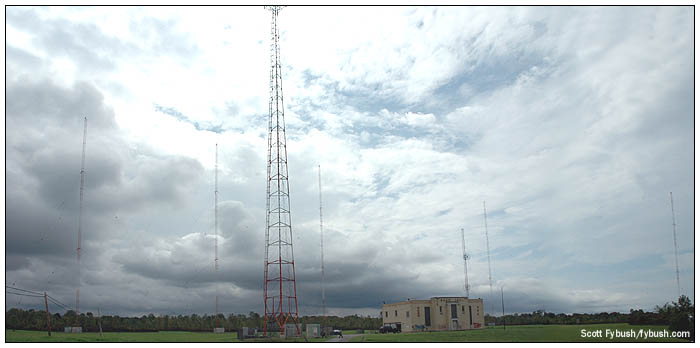
After a full day of visits to the towers and studios of Syracuse, we next turned our attention to our neighboring city to the west, Buffalo. For years and years and years, we've seen the lights of the city's biggest directional array as we've headed southwest out of town on the Thruway, and many times we've made the drive down Big Tree Road in the town of Hamburg to get a closer look at the array that's shared by WWKB (1520) and WGR (550) - but we'd never been inside the big building here until Mike came to visit.
Before we go inside, we need to do a bit of explaining about the tower configuration here, because it's confusing at first glimpse. The easiest part of the array is the DA-1 for 1520 - it's those three guyed towers seen at the left side of the composite picture above, behind the self-supporter. Day and night, they put a deep null to the southwest, protecting KOMA (now KOKC) in Oklahoma City. (The daytime null also allowed for a bunch of stations to set up shop on 1520 in Ohio, as close in as Kent and Canton, just a couple of hundred miles away.)
WGR is more complicated: it began as 5 kW days, 1 kW nights, DA-N, using the 328-foot guyed tower seen just to the right of the transmitter building by day and adding the leftmost of the WKBW towers to the array at night. In 1947, WGR raised its night power to 5 kW, adding the 355-foot self-supporting tower at the northeast corner of the property and a 328-foot guyed towers seen at the right (northwest) side of the picture to create a four-tower rectangular array for the night signal. Over the years, WGR has moved its non-directional daytime signal from tower to tower; it moved to the self-supporting tower in 1947, and then when the self-supporter acquired a ring of cellular antennas as leasing tenants a couple of years ago, WGR moved its daytime signal to the northeast corner of the property - the tower at the rightmost corner of this picture.
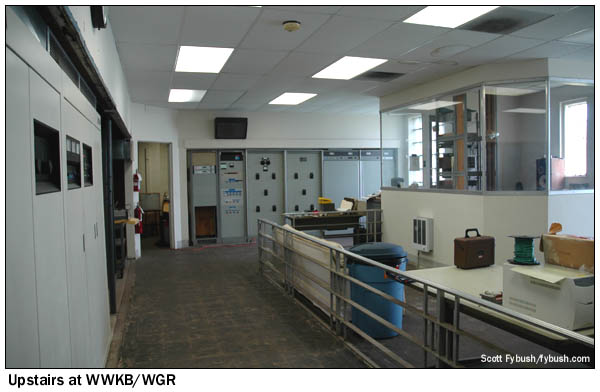 |
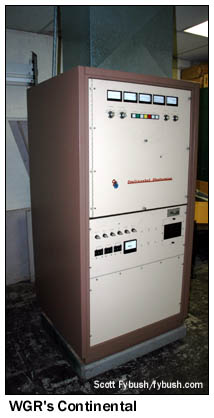 |
Shall we go inside the big yellow-brick building with the signs out front that say "WKBW," "WKBW INC." and "ABC"? Well, yes, at long last - but before we do, a few more words about the history here. When this site went on the air in October 1941, WKBW and WGR were under common BBC ownership. That wasn't the British Broadcasting Corporation, mind you - it was the BUFFALO Broadcasting Corporation, which took its obligations to the listeners of Buffalo just as seriously as that "other" BBC did to its audience.
So the BBC built a veritable palace out here on Big Tree Road, and they intended to share it with the public. Your average visitor of 1941 would have entered through the front door and walked up a stairwell lined with glass brick, arriving in a visitor gallery between the two control rooms, one (on the left in the photo below) for WGR, the other (at right) for WKBW. And beyond that railing in the middle of the floor, they'd have been looking at a wall of transmitters for both stations.
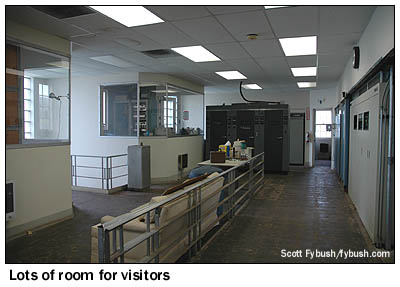
|
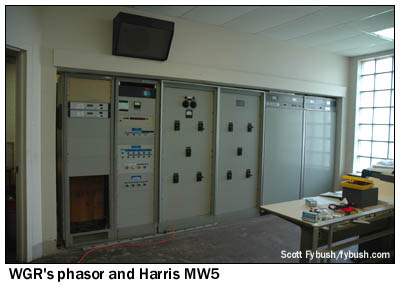
|
Unfortunately, that idyllic vision didn't last long. The start of World War II not long after the building was completed led to a big increase in security, so there were no more public tours of the building to be had. And the BBC didn't last much longer, either, at least in its two-station form. The FCC's decision to force duopoly owners to divest one station in each market meant that WKBW had to be spun off, returning to the hands of former owner Clinton Churchill while WGR stayed with Buffalo Broadcasting. Both stations would be sold again by the fifties, with WGR settling in for a long run under Taft Broadcasting and WKBW becoming an early property of a small company called Capital Cities Communications.
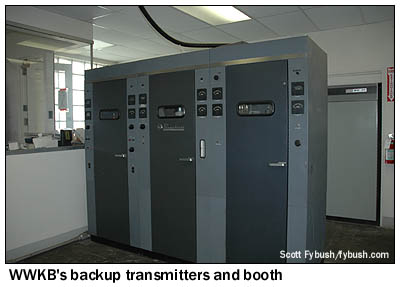
|
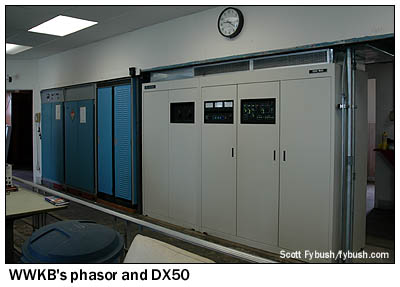
|
For the next half-century or so, this site thus ended up being shared by two fierce competitors - WKBW with the top-40 format that quickly became hugely popular not only in Buffalo but all up and down the East Coast, where the skywave signal from Hamburg blasted in to places such as New York City, Philadelphia and Springfield, Mass. all night long, often better than the "local" top-40 stations. WGR, meanwhile, evolved into a major full-service outlet aimed at slightly older listeners, finding plenty of success of its own.
With the coming of consolidation in the nineties, this site returned to a single owner, thanks to Sinclair's 1996 acquisition of 1520 (by then known as WWKB, after separating from its former TV sister station, which kept the WKBW calls) and its purchase the next year of WGR. Another sale later, both stations are owned by Entercom, which now programs them (and five other Buffalo stations) from new studios in an office park in Amherst.
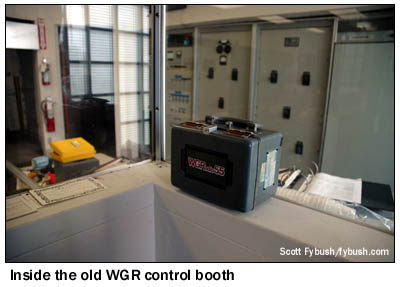 Today,
a visitor to this site can sense at least some of the majesty
it must have imparted back when it was new - even though these
days, the entrance is through the garage on the side of the building
rather than the front door, and the big tube transmitters that
once formed a big "U" around the visitor gallery and
the pair of control rooms are long gone, too.
Today,
a visitor to this site can sense at least some of the majesty
it must have imparted back when it was new - even though these
days, the entrance is through the garage on the side of the building
rather than the front door, and the big tube transmitters that
once formed a big "U" around the visitor gallery and
the pair of control rooms are long gone, too.
Coming up the stairs, the left side of the building is still the KB side, and these days it's a modern Harris DX50 pumping out the RF on 1520 most of the time. Next to the Harris is the phasor, which is built into an RCA cabinet even though it's not actually an RCA product. There is an RCA product over to the left of that, the BTA-10U 10 kW backup transmitter that's now the oldest box in the place. Behind that, an older Harris MW50 is available for backup use as well.
On the WGR side of the room, there are two 5 kW transmitters - a Harris MW5 that sits in the main room, and a Continental 315 tucked back in a corner. Both transmitters serve as alternate mains, feeding the phasor that sits between them.
The old control booths haven't been manned in many decades, and are mostly used for storage now. The same is true of the engineering bench behind the 1520 transmitters and the old bedrooms that line the back wall of the building. Even if they did suddenly decide to do public tours of this site, in this day and age it's hard to imagine very many people would care. But for those of us who can feel the history in a place like this, it's a neat place to be - and now you've seen it too.
The Tower Site Calendar 2007 is sold out! But we still have other back issues and more goodies availale at the Fybush.com Store - and check back very soon for your first chance to order Tower Site Calendar 2008!
- Previous Site of the Week: Syracuse, NY (part III)
- In Two Weeks: The Grand Island Sites, Buffalo, NY
- Site of the Week INDEX!
- How can you help support Site of the Week? Click here!
- Submit your suggestions for a future Site of the Week!
